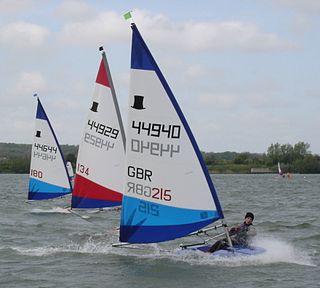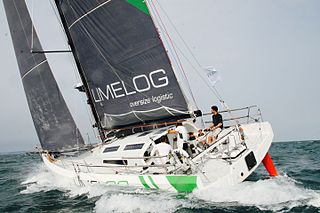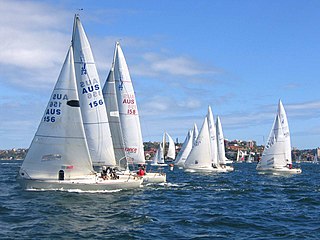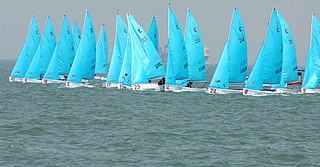Related Research Articles

Yacht racing is a sailing sport involving sailing yachts and larger sailboats, as distinguished from dinghy racing, which involves open boats. It is composed of multiple yachts, in direct competition, racing around a course marked by buoys or other fixed navigational devices or racing longer distances across open water from point-to-point. It can involve a series of races with buoy racing or multiple legs when point-to-point racing.
A match race is a race between two competitors, going head-to-head.
Team racing, also known as team sailing, is a popular form of dinghy racing and yacht racing. Two teams compete in a race, each sailing two to four boats of the same class. The winning team is decided by combining the results of each team's boats. This differs from an inter-club fleet race where boats from three or more clubs compete, with the results of each club's boats combined to determine its overall position.

Dinghy racing is a competitive sport using dinghies, which are small boats which may be rowboats, have an outboard motor, or be sailing dinghies. Dinghy racing has affected aspects of the modern sailing dinghy, including hull design, sail materials and sailplan, and techniques such as planing and trapezing.

The Topper is an 11 foot 43 kg (95 lb) sailing dinghy designed by Ian Proctor. The Topper was a one-design boat until 2023 when a new version was produced, and is sailed mostly around the British Isles. It was recognised as a World Sailing Class. The boat previously constructed from polypropylene, and now roto moulded, is popular as a racing boat or for sail training. The class association (ITCA) organise racing events, which range from small travellers to major championships. The RYA run squads alongside the events; in these squads young sailors who are given specialist race coaching.

World Sailing (WS) is the world governing body for the sport of sailing recognized by the International Olympic Committee and the International Paralympic Committee (IPC).

The Fastnet Race is a biennial offshore yacht race organized by the Royal Ocean Racing Club (RORC) of the United Kingdom with the assistance of the Royal Yacht Squadron in Cowes and the City of Cherbourg in France.
One-design racing is a racing method which may be adopted in sports using complex equipment, whereby all vehicles have identical or very similar designs or models, avoiding the need for a handicap system.

The A-Class Catamaran, often abbreviated to A-Cat, is a development class sailing catamaran for singlehanded racing.

The Formula 18 class, abbreviated F18, is a non-foiling, restricted development, formula-design sport catamaran class. It was started in the early 1990s and quickly grew getting class recognition by World Sailing, with large racing fleets all over the globe.
Performance Handicap Racing Fleet (PHRF) is a handicapping system used for yacht racing in North America. It allows dissimilar classes of sailboats to be raced against each other. The aim is to cancel out the inherent advantages and disadvantages of each class of boats, so that results reflect crew skill rather than equipment superiority.

The Newport Bermuda Race, commonly known as the Bermuda Race, is a biennial, 635 nautical miles (1175 km) sailing yacht race from Newport, Rhode Island to the British island of Bermuda. According to its website, the Race is the oldest regularly scheduled ocean race, and one of two regularly scheduled races "held almost entirely out of sight of land." Indian Harbor Yacht Club has recorded more entries in the Newport Bermuda Race than any other yacht club in the world.
The sport and practice of single-handed sailing or solo sailing is sailing with only one crewmember. The term usually refers to ocean and long-distance sailing and is used in competitive sailing and among Cruisers.

Class40 is a class of monohull sailboat and a yacht primarily used for short handed offshore and coastal racing. The class is administered by International Class40 Association which is recognised by the World Sailing.

The sport of sailing involves a variety of competitive sailing formats that are sanctioned through various sailing federations and yacht clubs. Racing disciplines include matches within a fleet of sailing craft, between a pair thereof or among teams. Additionally, there are specialized competitions that include setting speed records. Racing formats include both closed courses and point-to-point contests; they may be in sheltered waters, coast-wise or on the open ocean. Most competitions are held within defined classes or ratings that either entail one type of sailing craft to ensure a contest primarily of skill or rating the sailing craft to create classifications or handicaps.

Fleet racing is a form of competitive sailing that involves sailboats racing one another over a set course. It is the most common form of sailboat racing and contrasts with match racing and team racing.

The Transpac 52 (TP52) is a class of yacht used for competitive 52 Super Series yacht racing, and the Audi MedCup previously, besides the world championship of the class. The class is recognised by the International Sailing Federation which entitles the class to hold an Official World Championships.

The 2017–18 Volvo Ocean Race was the 13th edition of the round-the-world Volvo Ocean Race. It started in Alicante, Spain, and concluded in The Hague, Netherlands. GAC Pindar provides logistic support for the race. At the stopovers, teams had premium bases for better fan interaction.

Route Halifax Saint-Pierre Ocean Race is an ocean race held in late June or early July, every two years, from Halifax, Nova Scotia, Canada for a distance of approximately 350 nautical miles (650 km) to Saint-Pierre, in the French archipelago of Saint-Pierre et Miquelon off of coastal Newfoundland. It is raced by crews of two or more people, most commonly in sailboats in the 30 to 40 foot range, but boats from 21 feet (6.4 m) to 60 feet (18 m) have been raced in the past.
Low-point system is a point system in the Racing Rules of Sailing where all the boats in each race of the series score the same number of points as they finish in the race, so that the first boat to cross the finish line gets one point, the second two points. Boats that don't start, finish, retires or are disqualified are scored one more point than the total entrants of the series. For example, in a series with nine entrants, a disqualified boat scores 10 points in the race it is disqualified in. The low-point scoring system is usually used to score individual events with a fixed number of entrants. For season long series of events where the numbers of participants varies from race to race alternative scoring systems are in use.